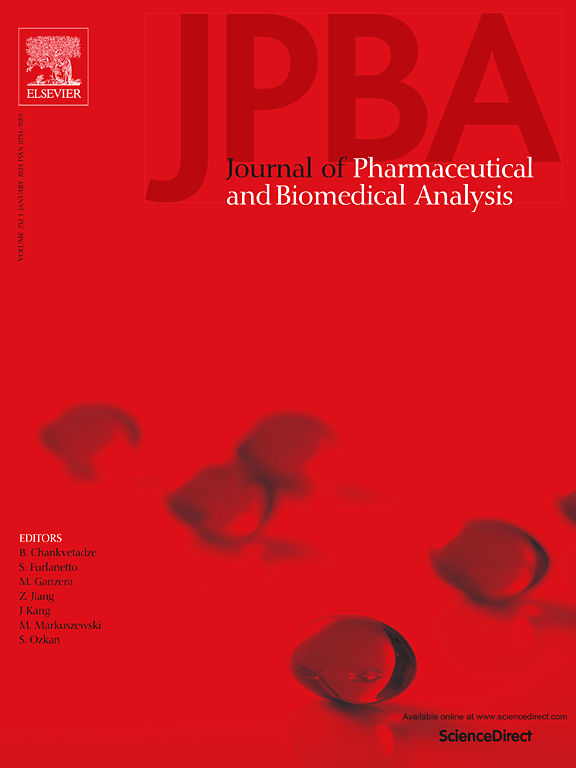基于血浆的宫颈癌患者肺部和淋巴结转移蛋白质组学和代谢组学特征。
IF 3.1
3区 医学
Q2 CHEMISTRY, ANALYTICAL
Journal of pharmaceutical and biomedical analysis
Pub Date : 2024-10-17
DOI:10.1016/j.jpba.2024.116521
引用次数: 0
摘要
转移是宫颈癌(CC)的主要致死原因,尤其以淋巴结和肺转移最为常见。已发生远处转移的宫颈癌患者通常预后较差,而目前尚缺乏预测宫颈癌转移的非侵入性策略。在这项研究中,我们利用无标记蛋白质组学和非靶向代谢组学分析了25例非转移、14例肺部转移和15例淋巴结转移CC患者的血浆样本。通路富集分析显示,两个转移组之间存在共同的炎症过程,而癌症的中心碳代谢在肺转移组中表现出明显的特征。此外,在淋巴结转移组中,胆固醇代谢、缺氧诱导因子1和铁变态反应信号通路也发生了特殊改变。利用接收者操作特征曲线分析和随机森林算法,我们确定了两个不同的生物标记物面板,分别用于预测肺转移和淋巴结转移。肺转移面板包括p properdin、神经细胞粘附分子1和角蛋白6 A,而淋巴结转移面板包括quiescin巯基氧化酶1、paraoxonase 1和角蛋白6 A。每个面板都显示出明显的诊断潜力,肺转移(训练集:0.989,测试集:0.789)和淋巴结转移(训练集:0.973,测试集:0.900)的曲线下面积(AUC)值都很高。该研究通过蛋白质组学和代谢组学的综合分析,阐明了导致CC肺转移和淋巴结转移的因素,并成功地建立了两个生物标记物面板用于预测肺转移和淋巴结转移。本文章由计算机程序翻译,如有差异,请以英文原文为准。
Plasma-based proteomic and metabolomic characterization of lung and lymph node metastases in cervical cancer patients
Metastasis is the leading cause of mortality in cervical cancer (CC), with a particular prevalence of lymph node and lung metastases. Patients with CC who have developed distant metastases typically face a poor prognosis, and there is a scarcity of non-invasive strategies for predicting CC metastasis. In this study, we utilized label-free proteomics and untargeted metabolomics to analyze plasma samples from 25 non-metastatic, 14 with lung metastasis, and 15 with lymph node metastasis CC patients. Pathway enrichment analysis revealed a shared inflammatory process between the two metastatic groups, while the central carbon metabolism in cancer showed distinct features in the lung metastasis cohort. Additionally, cholesterol metabolism, hypoxia-inducible factor 1, and ferroptosis signaling pathways were specifically altered in the lymph node metastasis group. Utilizing the receiver operating characteristic curve analysis and Random Forest algorithm, we identified two distinct biomarker panels for the prediction of lung metastasis and lymph node metastasis, respectively. The lung metastasis panel includes properdin, neural cell adhesion molecule 1, and keratin 6 A, whereas the lymph node metastasis panel consists of quiescin sulfhydryl oxidase 1, paraoxonase 1, and keratin 6 A. Each panel exhibited significant diagnostic potential, with high area under the curve (AUC) values for lung metastasis (training set: 0.989, testing set: 0.789) and lymph node metastasis (training set: 0.973, testing set: 0.900). This study conducted an integrated proteomic and metabolomic analysis to clarify the factors contributing to lung and lymph node metastases in CC and has successfully established two biomarker panels for their prediction.
求助全文
通过发布文献求助,成功后即可免费获取论文全文。
去求助
来源期刊
CiteScore
6.70
自引率
5.90%
发文量
588
审稿时长
37 days
期刊介绍:
This journal is an international medium directed towards the needs of academic, clinical, government and industrial analysis by publishing original research reports and critical reviews on pharmaceutical and biomedical analysis. It covers the interdisciplinary aspects of analysis in the pharmaceutical, biomedical and clinical sciences, including developments in analytical methodology, instrumentation, computation and interpretation. Submissions on novel applications focusing on drug purity and stability studies, pharmacokinetics, therapeutic monitoring, metabolic profiling; drug-related aspects of analytical biochemistry and forensic toxicology; quality assurance in the pharmaceutical industry are also welcome.
Studies from areas of well established and poorly selective methods, such as UV-VIS spectrophotometry (including derivative and multi-wavelength measurements), basic electroanalytical (potentiometric, polarographic and voltammetric) methods, fluorimetry, flow-injection analysis, etc. are accepted for publication in exceptional cases only, if a unique and substantial advantage over presently known systems is demonstrated. The same applies to the assay of simple drug formulations by any kind of methods and the determination of drugs in biological samples based merely on spiked samples. Drug purity/stability studies should contain information on the structure elucidation of the impurities/degradants.

 求助内容:
求助内容: 应助结果提醒方式:
应助结果提醒方式:


